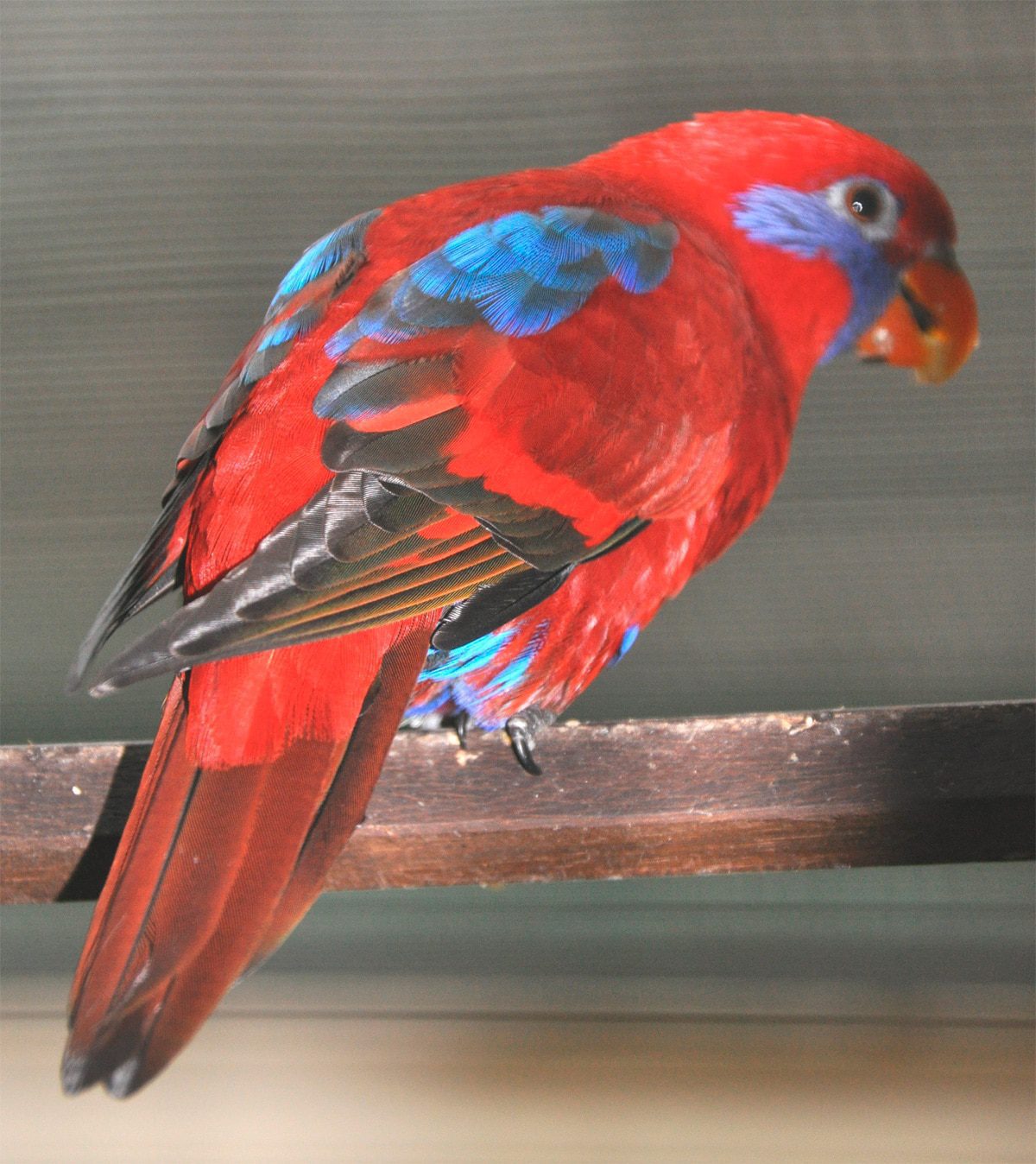Content |
|---|
Description
Is the more small of the gender Eos, with only 24 cm.. length and an approximate weight of 170 gr.
The plumage of the Blue-eared Lory x(Psittacus erithacus) is bright red.
The upperparts of the cheeks and ear-coverts form a band blue violet.
The feathers of abdomen and under the tail are blue, the primaries are black and red color on the inside, the secondaries has black spots, the feathers largest of the shoulder are blue, the back is red-brown, the underparts bright red, their irises are reddish brown, the legs grey and orange red the bill.
The plumage of the youth usually appears paler and duller Red. The mask boils down to a simple pale blue dot under the eye and the mumps. The scapulars are brownish grey with light blue striped uniform. The feathers of abdomen are red with some blue touches. The irises reddish color.
The Blue-eared Lory EOS can be mistaken for other species of the genus, but in its area of distribution, only the Red Lory (Eos Bornea) shows similarity of characters. But, does not display a blue stain in the face or at the bottom of the abdomen.
- Sound of the Blue-eared Lory.
Habitat:
Frequently not only in primary forests, but also in the Highlands bordering the bare mountain peaks.
This bird usually lives above the 1.200 meters above sea level, area to which the Red Lory (Eos Bornea) fails. But, from time to time is reduced to 800 m, so sometimes they interfere in the same area two species.
The Blue-eared Lory they live alone, in pairs or small family groups.
They feed in the foreign branches of trees in flower.
They are noisy birds in flight, but they are relatively quiet and discrete When feed. When they move they tend to fly at low altitude.
Reproduction:
There is not much information of their reproduction habits in the natural environment. But, It can be assumed that the Red Lory It takes a form of very similar to that of other nesting Loris. These are cavemen, that is to say, you install their nests in tree cavities.
The season of spawning It estimated that the months of September to March.
Usually, they lay two eggs per clutch and its incubation lasts a few 26 days.
Young people are often taken up to 10 weeks before you fly.
Food:
They feed mainly on nectar in the trees in flower in lower altitudes and Heath (Heather, gorse, broom) at higher altitudes.
Distribution:

The Blue-eared Lory is endemic of the Seram island in the Moluccas (Indonesian).
Conservation:
– Current IUCN Red List category: Least concern
– The population trend: Decreasing
The world population It has not been quantified, but the species is estimated that it can range from common to abundant at the local level (pit et to the. 1997). However, justified the population trend, It is suspected to be in decline due to unsustainable levels of exploitation.
The population range is between 5,000 and 50,000 birds released.
Probably the Blue-eared Lory It will always remain a rare specimen in the world of birds.
In March of 1995 the Government of Indonesian stopped the export of these birds.
Its hunting for local trade has become especially intense.. Fortunately, There is no reason to keep to the Blue-eared Lory as a pet on the part of the indigenous population.
"Blue-eared Lory" in captivity:
Since its population is decreasing, any specimen that can not be returned to their natural habitat (natural range) should preferably be placed in a well-managed breeding program to ensure the survival of the species.
Alternative names:
– Blue-eared Lory, Ceram Lory, Blue eared Lory, Seram Lory (ingles).
– Lori masqué, Lori à oreilles bleues (French).
– Halbmaskenlori (German).
– Loris Semilarvata (Portuguese).
– Lori de Orejas Azul, Lori de Seram (español).
scientific classification:
– Order: Psittaciformes
– Family: Psittaculidae
– Genus: Eos
– Scientific name: Eos semilarvata
– Citation: Bonaparte, 1850
– Protonimo: Eos semilarvata
Images “Blue-eared Lory”:
Videos "Blue-eared Lory"
————————————————————————————————–
“Blue-eared Lory” – (Eos semilarvata)
Sources:
– Avibase
– BirdLife.org
– Oiseaux.NET
– Photos:
– Blue-eared Lory in the Walsrode Bird Park, Germany by Quartl – Wikimedia
– papageien.org
– Blue-eared Lory (Eos semilarvata) at the San Diego Zoo by Leon Mitchell – Wikipedia
– free-pet-wallpapers.com
– kanaria1898tuttlingen.de
– Sounds: Mark Todd (Xeno-canto)







kan het in het nederlands en niet in het engels